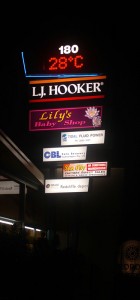Will a sign improve your business, and what type of sign should I invest in?
Coming from a sign industry background, I know anecdotally that YES a great looking sign will improve your business and your bottom line.
It is great to hear that from someone in the industry, but what are the facts and figures?
The international sign association posted a blog talking about this exact topic, they posted a table from a sign company that performed a study of their clients. The results were astoundingly in the favour of signage. With 50% of this business’ custom coming from their on premise sign. Unfortunately, the exact data, in relation to the collection type and the number of people surveyed was not readily available. I therefore, decided that we needed to look at this topic a little deeper, and see what other authors had to offer on the subject. (Click here to view the international sign association blog mentioned above)
My Google scholar search and subsequent article search for information on signs and business profits resulted in a plethora of articles and research. Much of the literature was about the subject of digital signage and the technology surrounding this. There was also some other interesting literature and opinions about the big end of town, and multinational investment in digital billboards and the target marketing campaigns that is available to the end users of this technology.
Digital Signage
The topic of digital signage, is one which is referenced quite regularly in the literature. Andrew Pierce, stated in his article the Power of Digital Signage that digital signage will increase sales on average 5%-30%, as well as increasing the time that customers spend in store (Pierce 2009). Digital signage also has the added benefits of being able to target marketing at a particular audience (Pierce 2009). He also goes on to state that the type of bulls-eye marketing that can be achieved by digital signage, is possibly the most profitable marketing tool available for decades (Pierce 2009). To ensure success with this type of signage, it is important that you ensure that you tailor your digital signage applications and usage with outcomes you are after. Like all types of signs it is important not to overdo any type of sign, as this can become too much and result in ‘sign blindness’ of your customers. Industry stats have been published saying that digital signage is increasing at a staggering 20+% per year (Brawn, 2013). Digital signage though is of a high initial cost and due to the technology involved there will be ongoing maintenance and costs associated with its application. Digital signage, though is proving to be the way forward, and with advances in technology, we can project our message from our signs to smart phones and directly into people’s lives. Although this does pose a rather ominous through, it does mean for the astute business owner, that targeted campaigns can be directly managed through signage, which is new to the world of sign, and offers tremendous potential.
Ensure your signs and marketing strategy are ‘one voice
Garden centre marketing guru, Daniel Truesdale is a firm believer in professional signage throughout the whole of business that ensure that all your marketing media are ‘singing from the same song sheet’ (Truesdale 2010). Part of this whole of business signage process, is ensuring that you are aware of where your business is coming from, where it is going to and most importantly your customer base (Truesdale 2010). With this in mind, your signage is guaranteed to be an integral part of your whole marketing process and in turn will ensure that you keep the customers you have and entice new customers to your business or service.
Signage Investment
The literature overwhelmingly supports the assertion that signs are positively linked to business profitability and growth. What was interesting to note is the large emphasis on digital signage and its ability to target marketing to all consumers. At this stage much of the large digital signage solutions are aimed at the large commercial entities, but with all things, as the technology advances, uptake increases costs will be driven down and the average business will soon be managing not only their digital presence, but their digital signage presence as well. The average sign, banner, and a-frame sign will not become obsolete, their place in the business sign market is firmly cemented, with digital signage becoming an adjunct to any organisations sign portfolio.

References:
Brawn, J. (2013). “The Real Cost of Digital Signage.” Sign Builder Illustrated 27(212): 32-36.
Everyone always immediately considers ad-based revenue, and that definitely has its place. In certain applications, such as retail, QSR, or hospitality, ad-based revenue is a natural fit and can definitely mitigate some of the expense of purchasing the signage system. In some cases, these revenues (if the venue fits and the audience is mere, demonstrable through metrics) can actually make the system turn a profit.
Pierce, A. (2009). “The Power of Digital Signage.” Picture Business 6(5): 20-21.
The digital signage solution also becomes more effective when tied to promotions. Furthermore, the technology behind digital signage has progressed to the point that the marketing messages can now be delivered based on the motion of the customer in front of the display or when a customer engages with a product on display. Digital signage can even determine the age and gender of the person in front of the display, and instantly deliver the marketing message that impacts that specific customer.
Truesdale, D. (2010). Finding Your Voice Through Signage. Today’s Garden Center. Willoughby, Meister Media Worldwide. 7: 26-27.
I’ll take that collective gasp as a cue io pause while you grab another cup of coffee. Gel ready, for this is where we are introducing a comprehensive 12-part Signs Sell Series dedicated to exploring the basics of branding, effective signage practices, visual merchandising and display and corporate brand consistency for garden center businesses. I think you’re going to like what you’re about to read.
By Claire Cox

